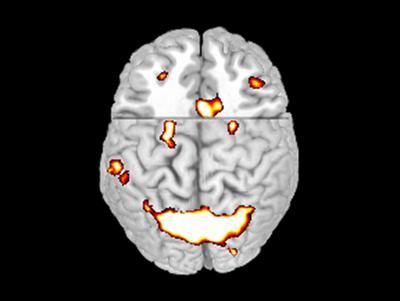A Georgia Tech researcher has discovered that for tasks involving spatial processing, preparing for the task and performing it are not two separate brain processes, but one – at least when there are a small number of actions to choose from. The research appears online in the journal Brain Research.
In a brain imaging study using functional magnetic resonance imaging (fMRI), Eric Schumacher, assistant professor of psychology at the Georgia Institute of Technology, along with colleagues from the University of Pittsburgh and the University of California, Berkeley, monitored the activity of brain regions in subjects while they responded to visual stimuli. A brain scan illustrates areas that became active when the subject was presented with a stimulus. In this study, those same areas also became active when the subject was cued to the task, indicating that the same areas of the brain that respond to stimulus also contribute to preparation. Credit: Eric Schumacher/Georgia Tech
A brain scan illustrates areas that became active when the subject was presented with a stimulus. In this study, those same areas also became active when the subject was cued to the task, indicating that the same areas of the brain that respond to stimulus also contribute to preparation. Credit: Eric Schumacher/Georgia Tech
The researchers predicted that when they gave the subjects a cue that they were about to perform a hard task, only the superior parietal cortex, known for its involvement in spatial attention, and the premotor cortex, known for planning movements, would activate. Then, the prefrontal cortex, known for its role in decision-making, would activate after the stimulus was presented. But they were wrong.
"We found that all of these regions began to activate when the subjects prepared to do the task, even the prefrontal, which is the region that makes the decision on what to do," said Schumacher. "Activating the decision-making region even before the stimulus is presented seems to allow for a quicker response, it allows the brain to get a running start."
Subjects were loaded into an MRI scanner and then shown a disk on a screen prompting them to press a button. They had two different tasks to perform, one labeled easy, and one hard. During the easy task, subjects were asked to push a button using the fingers of their left hand if the disk appeared on the left of the screen and their right hand if the disk appeared on the right. The hard task was manually incompatible, so that if the disk appeared on the left, they were to push the buttons using their right hand and vice-versa. Sometimes a visual cue prompted them that they were about to perform the hard or the easy task, sometimes it did not.
When the tasks were cued, all three regions of the brain increased their activity. When there was no cue, there was less activity.
So what does this mean in the real world?
"One analogous situation might be when you're driving and coming up on an intersection where there is a stale green light. You may get ready for the light to change to yellow and then red. My research suggests that this preparation for the upcoming change and appropriate responses involves the same brain regions that are involved in actually pressing the brake (or gas) once the light turns red or yellow," said Schumacher.
Written from a news release by Georgia Institute of Technology.